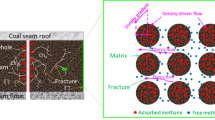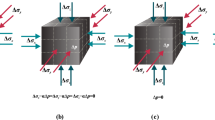Abstract
The permeability of a coal seam is an important index for coal mine gas control and coalbed methane development, and its magnitude determines the degree of difficulty of gas drainage. To obtain the permeability value, a dimensionless mathematical model for dual-porosity borehole gas-coupled flow in a coal seam was established and adopted using a simulator developed by our group. A new method of inversion was developed to determine the fracture permeability coefficient λf and the matrix micro-channel diffusion coefficient Km by fitting the simulated results with onsite measured data. A range of simulations quantified the effects of different dimensionless parameters on gas migration. The results verified the feasibility of the inversion method based on the high matching degree of the fitted results, and the dimensionless mathematical model was accurate. The desorption and release of adsorbed gas from the center to the surface in coal matrices were heterogeneous, and unsteady states and gas migration times in coal matrices cannot be neglected. The new method can be introduced to analyze the problem of gas migration in different coal reservoirs, simplify the corresponding calculation and computational processes, and provide guidance in determining the permeability of coal seams.












Similar content being viewed by others
References
Busch, A., Gensterblum, Y., Krooss, B. M., & Littke, R. (2004). Methane and carbon dioxide adsorption–diffusion experiments on coal: Upscaling and modeling. International Journal of Coal Geology, 60(2–4), 151–168.
Charrière, D., Pokryszka, Z., & Behra, P. (2010). Effect of pressure and temperature on diffusion of CO2 and CH4 into coal from the Lorraine basin. International Journal of Coal Geology, 81(4), 373–380. (in France).
Ertekin, T., King, G. R., & Schwerer, F. C. (1986). Dymnamic gas slippage: A ulnique dual-mechanism approach to the flow of gas in tight formations. SPE Formation Evaluation, 1(1), 43–52.
Feng, R., Harpalani, S., & Pandey, R. (2017). Evaluation of various pulse-decay laboratory permeability measurement techniques for highly stressed coals. Rock Mechanics and Rock Engineering, 50(2), 297–308.
Gray, I. (1987). Reservoir engineering in coal seams: Part 1—The physical process of gas storage and movement in coal seams. SPE Reservoir Engineering (Society of Petroleum Engineers), 2(1), 28–34.
Han, Y., Zhang, F., Yu, W., Yang, C., & Jiang, C. (2011). Experimental study on dynamic law of gas emission from borehole. Journal of China Coal Society, 36(11), 1874–1878.
He, C. (2018). Coal particle gas adsorption experiments and numerical simulation in enclosed space. Beijing: China University of Mining and Technology (Beijing).
Karacan, C. Ö., Ruiz, F. A., Cotè, M., & Phipps, S. (2011). Coal mine methane: A review of capture and utilization practices with benefits to mining safety and to greenhouse gas reduction. International Journal of Coal Geology, 86(2–3), 121–156.
Li, J., Liu, D., Yao, Y., Cai, Y., & Qiu, Y. (2011). Evaluation of the reservoir permeability of anthracite coals by geophysical logging data. International Journal of Coal Geology, 87(2), 121–127.
Lin, J., Ren, T., Cheng, Y., Nemcik, J., & Wang, G. (2019). Cyclic N2 injection for enhanced coal seam gas recovery: A laboratory study. Energy, 188, 116115.
Liu, J., Chen, Z., Elsworth, D., Miao, X., & Mao, X. (2010). Linking gas-sorption induced changes in coal permeability to directional strains through a modulus reduction ratio. International Journal of Coal Geology, 83(1), 21–30.
Liu, J., Chen, Z., Elsworth, D., Miao, X., & Mao, X. (2011). Evolution of coal permeability from stress-controlled to displacement-controlled swelling conditions. Fuel, 90(10), 2987–2997.
Liu, W., He, C., Qin, Y., & Liu, P. (2018a). Inversion of gas permeability coefficient of coal particle based on Darcy’s permeation model. Journal of Natural Gas Science and Engineering, 50(July 2017), 240–249.
Liu, P., Qin, Y., Liu, S., & Hao, Y. (2018b). Numerical modeling of gas flow in coal using a modified dual-porosity model: A multi-mechanistic approach and finite difference method. Rock Mechanics and Rock Engineering, 51(9), 2863–2880.
Liu, J., Qin, Y., Zhang, S., & He, C. (2019). Numerical solution for borehole methane flow in coal seam based on a new dual-porosity model. Journal of Natural Gas Science and Engineering. https://doi.org/10.1016/j.jngse.2019.102916.
McKee, C. R., Bumb, A. C., & Koenig, R. A. (1988). Stress-dependent permeability and porosity of coal and other geologic formations. SPE Formation Evaluation, 3(1), 81–91.
Mitra, A., Harpalani, S., & Liu, S. (2012). Laboratory measurement and modeling of coal permeability with continued methane production: Part 1—Laboratory results. Fuel, 94, 110–116.
Niu, Q., Cao, L., Sang, S., Zhou, X., Wang, Z., & Wu, Z. (2017). The adsorption-swelling and permeability characteristics of natural and reconstituted anthracite coals. Energy, 141, 2206–2217.
Palmer, I., & Mansoori, J. (1998). How permeability depends on stress and pore pressure in coalbeds: A new model. SPE Reservoir Engineering (Society of Petroleum Engineers), 1(6), 539–543.
Pan, Z., Connell, L. D., & Camilleri, M. (2010). Laboratory characterisation of coal reservoir permeability for primary and enhanced coalbed methane recovery. International Journal of Coal Geology, 82(3–4), 252–261.
Qin, Y., Hao, Y., Wang, Y., Liu, W., & Liu, P. (2013). Numerical solution of gas emission in coal particle based on two kinds of mathematical model. Journal of China University of Mining and Technology, 42(6), 923–928.
Qin, Y. P., & Liu, P. (2015). Experimental study on gas adsorption law in coal particle and its numerical analysis. Meitan Xuebao/Journal of the China Coal Society, 40(4), 749–753.
Qin, Y., Liu, P., & Hao, Y. (2017). Mathematical model and dimensionless numerical simulation of methane flow in a dual-porosity and dual-permeability coal seam. Chinese Journal of Rock Mechanics and Engineering, 36(1), 43–52.
Qin, Y., Liu, P., Liu, W., Hao, Y., Yang, Y., & He, C. (2016). Modeling and numerical simulation of borehole methane flow in a dual-porosity, dual-permeability coal seam. Journal of China University of Mining and Technology, 45(6), 1111–1117.
Robertson, E. P., & Christiansen, R. L. (2008). A permeability model for coal and other fractured, sorptive-elastic media. SPE Journal, 13(3), 314–324.
Shi, J. Q., & Durucan, S. (2004). Drawdown induced changes in permeability of coalbeds: A new interpretation of the reservoir response to primary recovery. Transport in Porous Media, 56(1), 1–16.
Thararoop, P., Karpyn, Z. T., & Ertekin, T. (2012). Development of a multi-mechanistic, dual-porosity, dual-permeability, numerical flow model for coalbed methane reservoirs. Journal of Natural Gas Science and Engineering, 8, 121–131.
Wang, K., Du, F., & Wang, G. (2017). Investigation of gas pressure and temperature effects on the permeability and steady-state time of Chinese anthracite coal: An experimental study. Journal of Natural Gas Science and Engineering, 40, 179–188.
Wang, Z., Sun, Y., Wang, Y., Zhang, J., & Sun, Z. (2019). A coupled model of air leakage in gas drainage and an active support sealing method for improving drainage performance. Fuel, 237(August 2018), 1217–1227.
Wang, K., Yu, Q., & Jiang, C. (2001). Study of dynamic gas emission during boring process by using numerical simulation. Journal of China Coal Society, 26(279–284), 1689–1699.
Wu, D. (2019). Experimental study and numerical simulation on adsorption of CO2, CH4 and N2 by coal particles. Beijing: China University of Mining and Technology (Beijing).
Xia, T., Zhou, F., Liu, J., Hu, S., & Liu, Y. (2014). A fully coupled coal deformation and compositional flow model for the control of the pre-mining coal seam gas extraction. International Journal of Rock Mechanics and Mining Sciences, 72, 138–148.
Xue, Y., Ranjith, P. G., Gao, F., Zhang, D., Cheng, H., Chong, Z., et al. (2017). Mechanical behaviour and permeability evolution of gas-containing coal from unloading confining pressure tests. Journal of Natural Gas Science and Engineering, 40, 336–346.
Zang, J., & Wang, K. (2016). A numerical model for simulating single-phase gas flow in anisotropic coal. Journal of Natural Gas Science and Engineering, 28, 153–172.
Zhou, F., Xia, T., Wang, X., Zhang, Y., Sun, Y., & Liu, J. (2016). Recent developments in coal mine methane extraction and utilization in China: A review. Journal of Natural Gas Science and Engineering, 31, 437–458.
Acknowledgments
This research was supported by the National Natural Science Foundation of China (51874315). Additionally, we greatly appreciate the comments of the editor and reviewers, which provided beneficial suggestions for our research.
Author information
Authors and Affiliations
Corresponding author
Rights and permissions
About this article
Cite this article
Liu, J., Qin, Y., Zhou, T. et al. Dual-Porosity Coupled Borehole Gas Flow Model: A New Method for Inversion of Coal Seam Permeability. Nat Resour Res 29, 3957–3971 (2020). https://doi.org/10.1007/s11053-020-09701-8
Received:
Accepted:
Published:
Issue Date:
DOI: https://doi.org/10.1007/s11053-020-09701-8




